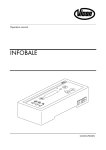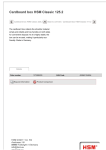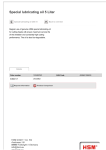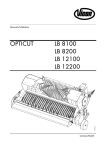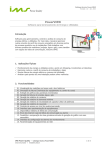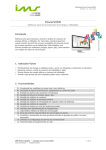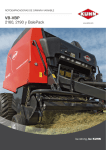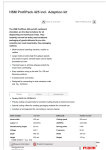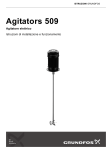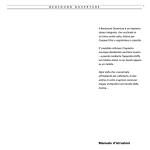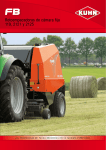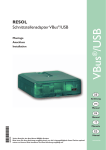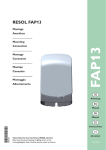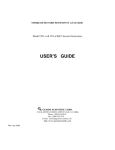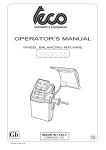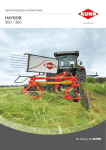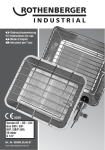Download AUTOFORM - Hjallerup Maskinforretning A/S
Transcript
Operation manual - C + AUTOFORM S T O P S T A R T F A U T O = G0204GPR(3)EN © Kverneland Geldrop BV, Nuenenseweg 165, NL-5667KP Geldrop DE: Dieses Buch und alle darin enthaltenen einzelnen Angaben und Abbildungen sind Urheberrechtlich geschützt. Jede Verwertung ausserhalb der Grenzen des Urheberrechts ist ohne ausdrückliche, schriftliche Zustimmung des Herausgebers unzulässig. Das gilt insbesondere für Vervielfältigungen aller Art, Übersetzungen, Mikroverfilmungen, einschliesslich Mikro- und Makrofiche, und die Einspeicherung und/oder Verarbeitung in elektronischen und optischen Systemen, einschliesslich aller Video und CD-Systeme. DK: Med forbehold af vor ret. Ingen del af denne bog må gengives, gemmes i database eller andet søgesystem, ej heller publiceres på nogen måde eller i nogen form, hverken elektronisk, mekanisk, optisk, på tryk, fotokopi, mikrofilm (incl. mikro- eller makrofiche) eller på anden vis – herunder alle video og CD systemer – uden forudgående skriftlig tilladelse fra udgiveren. EN: All rights reserved. No part of this book may be reproduced, stored in a data base or retrieval system, or published, in any form or in any way, electronically, mechanically, optically, by print, photoprint, microfilm (including micro and macro fiche), or any other means, including all video and CD systems, without prior written permission from the publisher. ES: El presente manual se acoge al amparo del Derecho de la Propiedad Intelectual. Salvo permisión escrita quedan reservados todos los derechos inherentes en especial los de reimpresión, de traducción, de reproducción en forma fotomecánica ó en cualquier otra forma, incluídos microfilmes, micro- y macrofichas así como el almacenamiento y procesamiento en sistemas electrónicos y ópticos, incluídos todos sistemas de video y CD, aún cuando no se utilice más que parcialmente texto o figura. FR: La propriété littéraire de ce manuel est protégée et les droits en découlant sont réservés. L'utilisation, même partielle, du texte es des illustrations n'est admissible qu'avec la permission écrite de l'auteur,en particulier la reproduction, la traduction, la restitution par des systèmes photomécaniques ou tous autres, y compris les microfilms, les micro- et macrofiches ainsi que la mise en mémoire et le traitement dans des installations électroniques et optiques, y compris les systèmes vidéo et CD. IT: Tutti i diritti di autore riservati. L'utilizzazione, anche parziale, del presente manuale, in particolare la ristampa, la traduzione, la riproduzione mediante microfilm, micro- e macroschede, come pure la memorizzazione e/o elaborazione tramite impianti elettronici, videosistemi e sistemi CD compresi, è ammessa solo se autorizata preventivamente dall'autore per iscritto. NL: Niets uit dit boek mag worden verveelvoudigd, opgeslagen in een, al dan niet, geautomatiseerd gegevensbestand of openbaar gemaakt; in enige vorm of op enige wijze hetzij electronisch, mechanisch, optisch, door fotokopieën, microverfilming (inclusief micro- en macrofiche), opnamen, of enig andere manier, inclusief alle video en CD-systemen, zonder voorafgaande schriftelijke toestemming van de uitgever. This workshop manual contains the instructions for the use and the maintenance of the electronic AUTOFORM system. It is a complementary manual to the other baler users manuals of the LB 8100 and LB 12100. The object of this manual is to help you achieve the benefits you expected when buying this baler. The output of your machine will depend to a large extent in your way of using it and maintaining it. It is very important to read this manual carefully before using the baler and to keep it handy. In this way, you will avoid accidents, respect the warranty conditions and always have a functional machine in perfect working order. Respect the security advice in this users manual and on the security stickers on the baler as well as the general security and accidental prescriptions. Table of contents: page Electronic control AUTOFORM 1 – Electronic control Autoform....... ................................................................................................................................2 1.1 Autoform...........................................................................................................................................................................2 1.2 Building in.................................................................................................................................................................3 1.3 Operating keys and switches.........................................................................................................................................4 2 – Working with the high density baler and the electronic control Autoform .................................................................5 2.1 Starting..............................................................................................................................................................................5 2.2 Working screens....... ...............................................................................................................................................5 2.3 Registration function ........................................................................................................................................................6 2.4 Function menu..................................................................................................................................................................6 2.5 Dealer functions........................................................................................................................................................7 3 – Baling process.....................................................................................................................................................................9 3.1 Setting the hydraulic density pressure...........................................................................................................................9 3.2 Setting the bale length ....... .................................................................................................................................. 12 4 – Fault messages................................................................................................................................................................. 14 4.1 Baling process alarms.................................................................................................................................................. 14 4.2 Technical alarms.................................................................................................................................................... 16 5 – Manually setting the density pressure .......................................................................................................................... 17 6 - Stopping baling................................................................................................................................................................ 20 6.1 Unhitching the baler..................................................................................................................................................... 20 6.2 Preparing for winter............................................................................................................................................... 20 7 - Factory functions ............................................................................................................................................................. 21 8 – Setting the sensors and indicators.................................................................................................................................. 24 9 – Diagrams .......................................................................................................................................................................... 29 10 – Trouble shooting table.................................................................................................................................................. 31 11 – EC Certificate of conformity........................................................................................................................................ 32 DANGER: When you see this safety alert symbol and heading be alert to the danger of injury of death of men and animals! Caution: When you see this heading, be alert to the possibility of damage to equipment, crop, buildings, etc., but to financial and/or juridical problems (warranty, product liability) as well! A remark, proposal, advise to facilitate a job. ©Kverneland 1 1) Electronic control ”Autoform” The high density baler comes with electronic control. This system controls and monitors the bale growth, the tying process and the pressure control. The system also features fault message functions. The control box allows the operator to control the entire baling process from the tractor. The main functions that are monitored include: - Bale length indication - Plunger load - Density pressure - Knives position - Overload packer - Twine position and functioning of the tying system 1.1 Autoform 1 2 3 4 5 6 7 8 9 Control box Connection cable control box Power cable PTO sensor Hydraulic block Pressure sensor (PRESS) Plunger load sensor (ML) Fans knotter cleaning Emergency switch fans 2 Sensors Because the Autoform system features extensive monitoring functions, the high density baler is equipped with a number of sensors. The following sensors are used on the baler: - Proximity sensors - Rotation sensors - Analog sensors 10 11 12 13 14 15 16 17 18 Bale chute sensor (SW) Tying sensor Bale chute alarm sensor Needle frame shear bolt sensor Twine sensor Baler control box Feed system overload sensor (FF) Knife position sensor (OC) Flywheel brake sensor © Kverneland 1.2) Building in Mount the AUTOFORM monitoring and control box (1) in the tractor cab within reach and view of the operator. The box has an on/off switch (2), a display and function keys. The baler control box (3) has a baler-geared control system. When unhitching the machine from the tractor, the connectors of cables (4) and (5) must always be pulled out and placed in the special holder. When the machine is not used for an extended period, the AUTOFORM control system must be switched off and the power cables must be pulled out. Connect the power cable (4) to the battery. Connect cable (5) to the control box. Fuses - - Monitoring and control box F1: 1*2A Machine control F2: 1 * 15 A (outputs and processor) 1 * 30 A (fans and 12V connector) When connecting the power cable to the battery, note the correct polarity. (+): brown cable (-): blue cable Never connect the cable to the cigarette lighter (interference risk), always directly to the interference-free power source (check the functioning of the fuses on the power cables). Keep cables away from hot and moving parts. ©Kverneland 3 1.3) Operating keys and switches Start Start of the Autoform control system. No function Delete (clear key) E.g. for last bale: reduce density pressure to 0 bar. Stop Stop the action, back to the basic screen. Activities are stopped Increase value No function Decrease value Registration Registration of bales and time per field. Confirm a value The value must no longer blink after confirmation. Function key, to next function, setting position or screen. Flywheel brake Pressing this button activates the flywheel brake to reduce the rpm more quickly Selection button automatic or manual density pressure control. I 0 II Main switch = ON = OFF = Emergency control Emergency control density pressure No function Switching knives on / off (option) 4 © Kverneland 2) Working with the high density baler and the electronic control Autoform 2.1) Starting Put the main switch to I. First the loading screen (d1) appears, automatically followed by the basic screen (d2). The basic screen is the main screen. This screen also appears when a d1 control function is interrupted with . When this screen is active, no further operations are possible (safe mode). When the baler is not used for a longer period, the power supply must be switched off. 2.2) Working screens d2 —> Press for the working screens. A working screen is a screen that is used for baling operations. During baling various working screens can be called up on . Every screen shows the the display by pressing plunger load (1), preset density pressure (2), actual density pressure (3) and bale growth (4). Each screen specifically provides information on: preset bale length (5) or plunger strokes most recently produced bale (6) or bales/hours (7) or number of bales produced (8) or pto speed (9). Press to select automatic cycle or manual control. The system starts in automatic mode. Manual control (10) is used when automatic density pressure control is not desired or not possible. In manual mode the indicator light above will be on. ©Kverneland 5 2.3) —> "Registration function” Store baling activities data. This function can be called up from the basic screen . With you can scroll through (select) the with screens J 01 to J 25. The selected screen (J06) can be allocated to a client or a field (06) to subsequently register the duration (00:31) and the number of bales (29). The registered time and number of bales can be reduced by pressing they can be reset (to 0) by pressing simultaneously. Confirm with or or and . As long as the indicator light above is blinking, the previous value can be restored by pressing or 2.4) . J 06 = 8 “Function menu” —> The function menu can be called up from the basic screen with . Pressing once again takes you to the next Function. With and you can switch the function in question on or off or decrease or increase a value. Every setting must be confirmed with . F 01 - Setting the bale length Detailed explanations can be found in the chapter "baling". F 02 - Fan Knotter cleaning using fans (option) can be switched on or off. F 03 - Compressor Knotter cleaning using a compressor (option) can be switched on or off. F 04 Automatic oil lubrication system The automatic oil lubrication system (option) can be switched on or off. F 05 Automatic grease lubrication system The automatic grease lubrication system (option) can be switched on or off. 6 © Kverneland F 06 Automatic knife cleaning Automatic knife cleaning system (only applicable for Opticut) can be switched on or off. F 07 Display contrast Adjust the display contrast (35 – 80 %) F 08 – Sound level The buzzer sound level can be adjusted from 0 to 100%. You can exit these functions at any moment by pressing . Caution: To work with the Registration function —> and the Function menu the baler must be stopped and the AUTOFORM control must be switched off by pressing (basic screen display appears). That blocks all other functions that might damage the (running) machine. 2.5) Dealer functions —> With the electronic control box a number of functions can be set / read out by the dealer or the user. Operation: 1) Go (back) to the basic screen. and - simultaneously to call 2) Press up the F+01 screen. you can go through this menu and With adjust any settings. F+01 Correction bale length sensor The bale growth per bale length sensor pulse can be corrected here. F+02 Time setting of the pneumatic knotter cleaning Set at 1 sec. cleaning and 10 sec. pause. F+03 Time setting automatic oil lubrication system Set at 1 sec. lubrication and 10 sec. pause. ©Kverneland 7 F+04 Time setting automatic grease lubrication system Set at 1 sec. lubrication and 10 sec. pause. F+05 Time setting automatic knives cleaning Set at 20 sec. cleaning and 1 min pause. F+06 Calibration pressure sensor Measured value and input value pressure sensor (P). F+07 Total number of bales produced on the machine F+08 Total baling time F+09 Switching sensors on and off The sensors can be switched on and off using and . The setting must be confirmed with . If one of these sensors is switched off, the system goes to manual mode. F+10 Switching sensors on and off The sensors can be switched on and off using and . The setting must be confirmed with F+11 Switching sensors on and off The sensors can be switched on and off using and . The setting must be confirmed with 8 . . © Kverneland 3) Baling process Caution: it is vital to let the machine run at 1000 rpm speed during use. Only then can flawless operation of the various functions be guaranteed. The forward speed (choice of gear) must always be adapted to the swath width. To achieve maximum bale density, the separate wads in the bale must not be thicker than 5 cm. If large quantities regularly cause packer overload, then the forward speed must be reduced. Adapt the forward speed to the number of compression strokes per bale. The working screen showing the plunger strokes per bale is a good tool here. Examples: Bale length (in cm) 80 120 160 180 200 220 240 250 260 Number of strokes per bale 16 24 32 36 40 44 48 50 52 3.1) Setting the hydraulic density pressure The function of the automatic density pressure control of the electronic control system AUTOFORM switches is automatic. If the indicator light above the button is on, that means that the automatic density pressure control is active. When the baler is switched on, the electronic control system AUTOFORM automatically switches to the preset density pressure. Display Growth bar (1): - indication of the plunger load (ML) Value (2): - preset density pressure Value (3): - actual density pressure The actual density pressure (3) must quickly be equal to the preset value (2) and for that reason it will constantly be measured and adjusted. ©Kverneland 9 The pressure control can also be operated manually. That is indicated by a little hand on the working screen. In addition, the indicator light above will be on. Change the pressure value with and . The measured pressure can be a read out from the working screen. (More about manual operation on page 17). Caution: the maximum permissible density pressure is 170 bar! Wait till the desired density pressure has been reached through letting run the tractor pto for a few minutes without baling! The preset pressure value must never be exceeded. The control system AUTOFORM regulates the density pressure between 0 bar and the preset value. In the event of a plunger overload the hydraulic pressure in the cylinders of the bale chamber guide will automatically be reduced. When the load on the plunger is reduced, the density pressure is automatically built up again to the preset value. Adapt the pressure to the working conditions (crop type, crop humidity, swath shape, twine resistance, etc.). Caution: Snapping twine after the bale is ejected or frequent activation of the flywheel coupling are signs of plunger overload. Then the preset maximum pressure must be reduced using 10 . © Kverneland Plunger overload alarm: - plunger overload calls up a warning on the display and activates the buzzer; - the automatic density pressure control is triggered, the pressure drops in 5 bar increments until the plunger load has reached a normal level again. If the alarm persists, you should reduce the preset pressure or the forward speed. rapidly reduces the hydraulic pressure Pressing to 0. The preset pressure remains stored in the memory and can be activated again by pressing or . Calibrating the pressure sensor The pressure sensor must send accurate information to the electric system. If it doesn't, calibration is required for a new basic setting. Reduce the hydraulic pressure in the baling system to zero. In —> on screen the Function plus menu F+05 the measured value can be read out for the pressure sensor (11). In the example that is 8. Then this value must be entered as calibration value (12) for ”0 bar”. This action is simplified by pressing twice. The factory setting is 1 (count) but the sensor must regularly be calibrated because of possible deviations. Store the entered value by pressing . The value stops blinking. Press to leave the F+05 menu. Correct operation of the pressure sensor can be checked by setting the pressure to 150 bar (read from the pressure gauge) and reading out the value in the F+05 screen. Then a value of 625 ± 20 should appear at (11). ©Kverneland 11 3.2) Setting the bale length Caution: The bale length is set mechanically. Autoform monitors and controls the bale length. Setting the automatic bale length control Entering the bale length in the control box AUTOFORM. from the - Call up the main function by pressing basic screen. That takes you directly to screen F01, setting the bale length. - The factory setting is 2.0 m. and the bale length setting can be - With increased or decreased. - the setting range is 0.5 m to 3.0 m. confirms the selected length. Then the - Pressing value in question no longer blinks on the display. - This function can be interrupted at any moment by . pressing - Preset bale length: 1.8 m in this example. Bale growth In the working screens the display always shows the bale growth (4). This value matches the actual length (in metres) of the bale that is being produced. This value shows the increase of the bale length. When a bale is being tied (knotted) the actual bale length on the screen is set to 0. A new bale can be made. Calibration of the bale length sensor The bale length sensor must send correct information to the electronic system. If it does not, calibration is required. After producing a bale of the required length, the length indicated on the display must match the actually produced length (= set mechanically): Correct any difference as follows: - Go to the dealer functions by pressing and subsequently . - The first screen (F+01) shows the relevant message. - Default value is 13 mm bale growth/pulse. 12 © Kverneland - Pressing or corrects the value. - Set a value for the coefficient of variation between the actual value and the displayed value. Example: Actual value (measure): 2.0 m, displayed (display): 2.4 m; reduce the preset pulse value 13 mm / pulse to: 13 x 2.0 / 2.4 = 11 mm / pulse. . Then the displayed value - Confirm by pressing no longer blinks. - At any moment this function can be interrupted by pressing . This procedure must be repeated until the displayed information is correct. If working conditions (crop) change, recalibration may be required. Caution: only set the star wheel increment size after setting the knotter activation so the bale length setting will be realised by Autoform. ©Kverneland 13 4) Fault messages Caution: A beep warns the operator that a baler fault has occurred. Every fault message appears separately on the control box display in order of priority If a fault is reported, then stop baling at once and remedy the fault before continuing work. Ignoring the fault message and continuing work may cause considerable material and financial damage. The fault messages are roughly divided into two groups: - - Baling process alarms Technical alarms 4.1) Baling process alarms Bale chute alarm (BA1). This message appears in the working screen when it has been detected that the bale chute is not yet in baling position. Lower the chute. BA1 Flywheel brake activated (BA2). This message appears when the mechanical flywheel brake is in braking position. Switch off the flywheel brake. BA2 Emergency stop fans (option) activated (BA3). The emergency stop button of the fan (knotter cleaning) has been pressed. Shear bolt needle frame failed (BA4) This message appears when needle frame shear bolt has failed. Find the cause and remedy the problem. Replace the shear bolt and activate the tying process. 14 BA3 BA4 © Kverneland Plunger overload alarm (ML) (BA5) This message appears when the plunger load becomes too high. In that event the density pressure is reduced in 5 bar increments until the plunger load is back to normal. Then the preset density pressure is automatically restored. Feed system overload sensor (BA6) When the fault message is repeated, you should reduce the forward speed. In the event of a constant alarm, check the bale chamber for foreign objects, you should try to find an electronic or mechanic failure in the packer system. A too high load on the packer disengages the packer camclutch. Autoform automatically responds to this by switching off the Opticut knives (option) and activating the flywheel brake (option). When the alarm has been a reset, the operator must manually switch on the Opticut again. Incorrect bale length (BA7) Bale length does not match value set at "main functions". Check the bale length setting. Needle frame shear bolt failed. Find the cause and remedy the problem. Mount new shear bolt. Twine failure message (BA8) If one or more knotters is not fed with twine, a warning message appears. Remedy the malfunction. The display in this example gives a twine failure message for the left-hand twine arm and one or more for intermediate twine arms. PTO alarm —> rpm too high (BA9) A too high pto rpm increases the risk of material damage. Autoform generates an alarm at a pto speed higher than 1100 rpm. Decrease the tractor engine rpm. PTO alarm —> rpm too low (BA10) If the rpm is too low some baler functions cannot respond quick enough. Increase the rpm. ©Kverneland BA5 BA6 BA7 BA8 BA9 BA10 15 Knife position —> not as set (BA11) The knife position is detected differently than set. Find the cause and remedy the problem. The knife position alarm can be reset by switching the knives off and on again or by stopping the system and restarting. 4.2) BA11 Technical alarms Bad connection between baler control box and onboard computer - Check all electrical connections. - Check battery voltage. TA 1 Short-circuit D12 V connector 1 Short-circuit in the 12 V digital circuit of connector 1 (see arrow). TA 2 Short-circuit D12 V connector 2 Short-circuit in the 12 V digital circuit of connector 2 (see arrow). TA 3 Short-circuit A12 V connector 2 Short-circuit in the 12 V analog circuit of connector 2. TA 4 Battery voltage too low The battery voltage is lower than 9 V. When fault messages appear repeatedly, function disruptions in the electronic control system may occur. Remedy the function disruption. TA 5 No ML sensor No ML sensor is detected, so no plunger load can be indicated. Remedy the problem. TA 6 No pto sensor No pto sensor is detected. Remedy the problem. TA 7 16 © Kverneland 5) Manually setting the density pressure Setting the hydraulic pressure in manual mode The manual setting of the density pressure is confirmed by the symbol of a hand on the display. The indicator light above the button is on. In manual mode the operator directly determines the hydraulic pressure (3) of the density pressure control. The preset pressure value (= desired pressure value) on the screen is replaced by the symbol of a hand (10). The plunger load is displayed with a growth bar (1); the bar height indicates the load. The hydraulic pressure of the density pressure control can be set with and . The value of the density pressure (1) on the display varies between 0 and 170 bar. The setting of this value can be changed at any moment. Switch on the tractor pto so the value of the hydraulic pressure is shown on the display (3). Plunger overload alarm - Plunger overload calls up a warning on the display and activates the buzzer. - The automatic density pressure control is disengaged, the pressure drops in 5 bar increments until the plunger load has reached a normal level again. This applies to automatic density control only. Caution: If the system is in manual mode, the originally set value will not be restored after a plunger load alarm. If the alarm persists, you should reduce the preset pressure or the forward speed. ©Kverneland 17 Why working with the machine in manual mode? It is possible to switch the AUTOFORM control system to manual mode in case of a defective sensor. If the alarm keeps recurring, it can be deactivated by switching off the sensor in question. That can be done in the dealer functions (F+) menu. If the PTO, FF, P or ML sensors (display F+08) are deactivated, the operating settings switches to manual mode until the sensor has been switched back on and works properly. For the other sensors it remains possible to work with automatic density pressure control by pressing . Manual mode is confirmed by the symbol of a hand on the display. In addition, a wrench is shown on the right of the display (defective sensor). Caution: As soon as a defective connection or an alarm is shown, the cause must be traced and remedied. Getting the most out of your baler's capacity requires that you work with it with the control system in automatic mode. As long as the connection has not been repaired, the alarm symbol will be displayed as long as the system is on. Switching a sensor on and off A sensor can be switched off in the dealer functions menu (F+9, F+10, F+11). A sensor is switched off by removing the cross before the relevant sensor name. Select the desired sensor with switch it off with . Confirm with scroll through screen and menu. and and then and with Observe the following safety precautions in manual mode. When working with the baler in manual mode with one or more sensors switched off, certain safety precautions must be observed. 18 © Kverneland Caution: manual mode makes it possible to continue working with the baler for a short period despite a fault in one or more connections. That way a field or plot can be completed. The moment a connection fault occurs, the cause must be traced and remedied as soon as possible. Work with the electronic control system in AUTO mode to gain full benefit of the system and thus of the baler. - When the hydraulic pressure sensor is switched off, the operator must observe the pressure values indicated on the pressure gauge (front baler). - When the plunger overload sensor has been switched off, the electronic control system no longer registers the plunger load. In this case the alarm message "plunger overload" will not be shown. Caution: In any event the overload limit will be the flywheel safety or a twine failure on ejection of the bale from the bale chamber. Electric emergency control density pressure In the event of an electronic problem, the AUTOFORM control system still offers a possibility to control the density pressure. Before the AUTOFORM control system of the baler is switched off, the monitor function must be set to standby mode: press the key "STOP". Only switch off the AUTOFORM control system when the display is on standby. in Put the main switch under the control box position (II). Operate the pump using the control switch on the side. Repeat this procedure regularly (every 30 sec, depending on frequency of reading the manometre). Now the operator can read the desired pressure from the pressure gauge. The density pressure is set by rotating the hand wheel of the proportional valve (V5) on the hydraulic valve block (also see page 29)! This procedure must NEVER be performed during work! Caution: The emergency control makes it possible to continue work despite one or more defects. In all cases it is important to remedy the problem quickly. Working quickly and accurately with the baler requires that the machine is in automatic mode. ©Kverneland 19 6) Stopping baling Stop picking up and let the machine run for a few moments to transport the crop that is still in the chamber, then switch off the pto. For transport of the baler the electronic control system AUTOFORM . Before must be switched off by pressing continuing baling, the system must be activated again with . Act as follows to eject the last bale: - start a tying process; - take the pressure from the density pressure circuit: let the machine run and set the preset value to 0 using ; - switch off the pto after some time; - disconnect the power supply to the electronic control system AUTOFORM. 6.1) Unhitching the baler When unhitching the baler from the tractor, the cables of the AUTOFORM control system must be disconnected. 6.2) Preparing for winter - dismount the control box and store it in a dry place, free of insects and rodents. - do not use high-pressure water or steam cleaners within the area of the electronic control panel and the electric connections. When you observe the above rules, you will have a fully operable machine at the start of the next harvest season. Consult your dealer if you have any questions. Before taking into use again, all adjustment activities described in the user manual must be carried out. 20 © Kverneland 7) Factory Functions —> Simultaneously pressing and calls up the Factory Functions. This menu is intended for engineers. The factory functions include two menus, —> test and settings. Caution: When calling up Factory Functions, stop the baler at once. You can exit the Factory Functions at any moment by pressing All data remain stored in the system (through battery). . Test menu ©Kverneland • Menu selection test / settings • Test menu selected • Volt. digital connector 1 • • D12 V = voltage measured on connector 11.7 V = current voltage • • 0 = deactivate 1 = activate • • 0 = deactivate 1 = activate • • • • V2 = knives in V3 = knives out V4 = hydraulic flywheel brake (V= valve) • • • Pneumatic knotter cleaning Automatic lubrication Spare valve 1 • • • • Spare valve 2 V5 (prop.) V1 (pump) (V = valve) • • 0 = deactivate 1 = activate • TMO • Unused • Spare motor • Unused • • • • Inputs: Flywheel brake sensor Spare 2 Spare 3 • • 0 = no signal 1 = signal • • • • Inputs: Spare 4 Spare 5 Spare 6 • • 0 = no signal 1 = signal 21 • Electric fans knotter cleaning • • • = Clockwise stop = deactivate = Counterclockwise • Volt. Analog 5 V and 12 V sensors + dig.12 V sensors on connector 2 • • • • • • • If value = 0, there is a system short-circuit A5V = 5 V (unused) A12V < 9 V = alarm A12V < 9 V = alarm P = 459 —> current value TW = 0 —> current value ML = 373 —> current value • Unused • • 0 = no signal 1 = signal Test Anal. Sensors: • P = Pressure sensor • TW = Twine sensors • ML = Plunger load sensor 22 • Testing analog inputs 4, 5 and 6 • • • • • • • • Test input: Bind = Bale counter + resetting bale length PTO = pto sensor FF = packer sensor Test input: OC = knife position sensor SW A = bale length sensor A SW B = bale length sensor B • • 0 = no signal 1 = signal • • • • Test input: Needle frame shear bolt sensor • • Bale shute position sensor Fan emergency switch 0 = no signal 1 = signal • Keyboard test screen for keys and LEDs • Press a key —> The key number appears on the display and the LED will go out. Press a key twice to return to the basic screen. © Kverneland Test menu (may not be changed) • Menu selection test / settings • Settings - menu is selected • Onboard computer software version • V1.07 19 – 07 – 00 = software version • Implement software version • V1.07 19 – 07 – 00 = software version • PIN code • Not applicable • ML- offset • 15 = current value (counts) of sensor 170 = setting for ML sensor if no load • • ML- max. setting • • • ML alarm setting • • ©Kverneland 14 = current value (counts) of sensor 500 = growth bar fully black at 500 counts 14 = current value (counts) of sensor 600 = setting for plunger load alarm • Total number of bales produced on the machine • Cannot be changed • Total baling time of the machine • Cannot be changed • Current time • Cannot be changed • Current date • Cannot be changed 23 8) Setting the sensors and indicators Proximity sensors The proximity sensors trace metal objects. - Tying sensor (BIND) (situated at the needle frame) - Packer sensor (FF) (situated at left hand side of the intake rotor) - Power take-off sensor (PTO) (top view of the main gearbox) Set dimension (A) of the sensors must be between 2 and 6 mm, measured up to the metal surface. The connected sensor indicator light will be on. 24 © Kverneland - Bale chute alarm sensor (Chute) - Flywheel - Needle frame shear bolt sensor Set dimension (A) of the sensors must be between 2 and 6 mm, measured up to the metal surface. The connected sensor indicator light will be on. ©Kverneland 25 - Knives frame position sensor (OC) (situated at the knife frame) - Bale length sensor (SW) The bale length is measured by a sensor that runs in a bearing (13). It is mounted on the shaft behind the starwheel for mechanical bale length setting. This sensor can count positive as well as negative. If the bale moves back and forth in the bale chamber, the measurement will still remain correct. Each time the needle swing is disengaged the value will be set to 0. - Sensor plunger overload (ML) The read-out value of the plunger overload must be 170 when unloaded (0 bar). The value can be checked in the settings menu of the factory functions. If the value unloaded is not 170 ± 5, the “calibration value” must be set again. Procedure: - Open screen FS04 of the factory functions settings menu. That shows the current value of the ML sensor (in the example 15). It must be 170 when unloaded (offset). - With the aid of the nuts (14) of the ML sensor the sensor position can be shifted. Performance of the hydraulic density pressure control: In certain crops (high humidity, large swath etc.) the plunger overload may be activated before the flywheel overload. Plunger load is measured by a sensor. As soon as the preset maximum value is reached, the control system AUTOFORM adjusts the proportional valve V5 (see hydraulic diagram). A dropping hydraulic pressure of the density pressure control opens the three panels of the bale chamber, reducing the plunger load. 26 © Kverneland - Twine sensor – (dependent on version) (TWINE) • The sensor (15) is activated by a magnet (16) on the twine arm. If twine tension fails a spring presses down the arm, causing a message “twine problem”. • The spacing between the sensor (15) and the magnet (16) must be between 20 and 25 mm with the lever on the stop in the bottom position. ©Kverneland 27 9) 28 Diagrams © Kverneland ©Kverneland 29 30 © Kverneland 10) Trouble shooting table Caution: the electronic control system operates reliably. Most malfunctions are caused by incorrect connections. The central operating panel on the machine may only be opened by people with sufficient expertise. Make sure no dirt gets into the opened central operating panel. MALFUNCTION CAUSE SOLUTION - no message on the monitoring and control box - no power supply to the control system - switch on the device - alarm « no connection » appears on the display - control box not equipped with "HIGH DENSITY BALER" computer program" - switch off and back on at proper power supply - check power supply of central control panel - switch on central control panel - switch monitoring and control box off and on again - internal control system problem - consult your dealer - bale length does not match preset value - incorrect setting increment size - recalibrate sensor - automatic density pressure control does not work - faulty operation pressure sensor - calibrate pressure sensor (page 10) - Defective PTO sensor - ML sensor set incorrectly - incorrect preset value in computer program ©Kverneland - check the system power - check fuses - check pressure sensor - check adjustment - check connexion - change sensor - check the sensor setting - set ML – sensor (170 in rest) (page 23) - switch to "MANUAL" mode - warn dealer 31 11) CE Certificate of Conformity CE CERTIFICATE OF CONFORMITY in accordance with the EU-Directive 89/392/EEC We, Kverneland Geldrop BV, Nuenenseweg 165, NL-5667KP Geldrop declare under our sole responsibility that the product: Big square baler, type LB to which this declaration relates corresponds to the relevant basic safety and health requirements of the Directives 89/392/EEC (amended with 91/368/EEC, 93/44/EEC and 93/68/EEC) and 98/37/EC. For the relevant implementation of the safety and health requirements mentioned in the Directives, the following standards have been respected: EN292-2, EN294, EN704 Geldrop, 20 April 2002 Casper Böhme General Manager "KVERNELAND GELDROP BV" manufacturers of farm machinery reserve the right to change design and/or specifications without notice. This does not include an obligation to make changes to machines previously supplied. 32 © Kverneland KVERNELAND GELDROP BV Nuenenseweg 165 Postbus 9 NL 5660 AA Geldrop The Netherlands Tel. +31 40 289 33 00 Fax +31 40 285 32 15 Prod. Series No. (PSN): 510212, 510211 Gültig ab Produkt Identifikations Nr. (PIN): À partir du no. d’identité du produit (PIN): Effective from product identification no. (PIN): Vanaf product identificatie nr. (PIN): 218075 216066 printed 2002-05-24 © Kverneland Vicon is a brand of the Kverneland group G0204GPR(3)EN



































